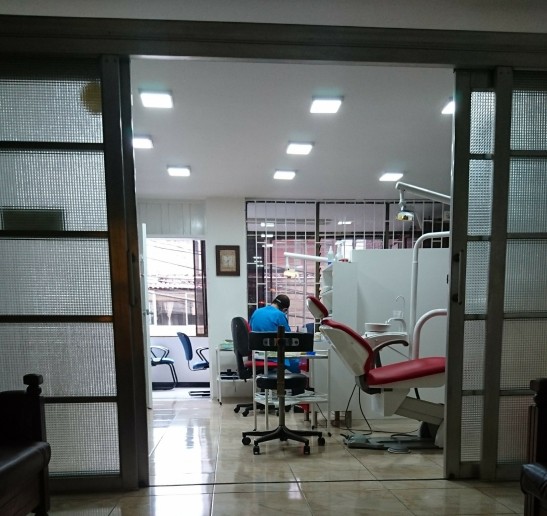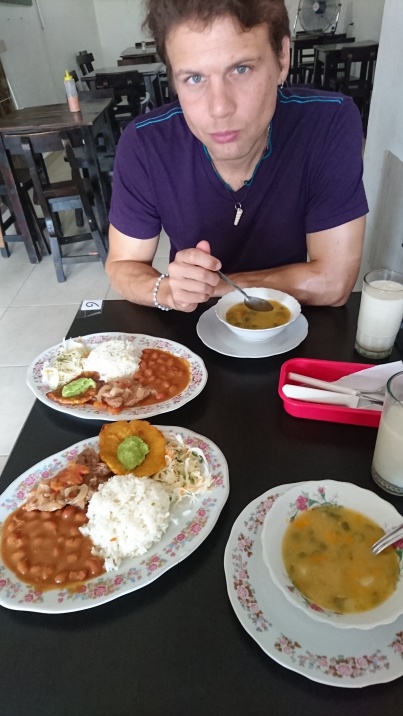October 4, 2017
by Christina
Around mid-day on Tuesday, we headed to the Caribe metro station which gives you access to the North Bus terminal in Medellin. There we bought tickets to Guatapé (you can do so from Ticket Booth 9 or 14). Reading online, there is a lot of advice to haggle about price. We were asked for $13,500 COP per ticket, but I said that I thought the tickets were $12,000, and she said okay with no argument. Turns out when we were handed the tickets, it said the value was $11,000. Harumph, but oh well.
It was a beautiful, jostle-y two hour ride out to Guatapé (a little beyond the main attraction: the rock), where we checked in at La Casona Guatapé, which is nice and clean, with some cool terraces and a small but adequate kitchen. We immediately got out our running gear and headed off to the rock, El Peñol de Guatapé. There is a very picturesque, poorly maintained sidewalk (with stunning views and suspension bridge) for about 2 of the 3 km from Guatapé to the rock. The last kilometer you’re basically walking (or running in our case) on a narrow 2 lane road. We didn’t have any problems, but this a “do with caution” type activity.
The entrance to the rock from the road is a bit of steep hike, and our run mostly slowed to a walk at this point. Or you can take a Tuk tuk. Then its 700+ steps to the top of the rock and up a spiral staircase to an epic view of the surrounding landscape. The lake is actually a reservoir that was created when the hydroelectric Punchiná Dam was built in the 1970s and ’80s and is a bit tourist attraction not just for foreigners, but for Colombian tourists as well. It’s one of the most beautiful things we’ve seen so far on our trip. Really.
We would recommend packing a picnic to eat atop it, though there is (pricey) food and drink available at the top (and of course, lots of souvenir shops). Entrance to the rock was $18,000 COP, a lot higher than what I had read online ($10,000 COP) so I think they must have recently increased prices. After a stunning sun set and a twilight run back to Guatapé, we took a turn about the city at night. The church in the main square is lit beautiful with a cycling light pattern that’s mesmerizing.
We only stayed one night in Guatapé, and so we spent the next day having a look around town. It’s an incredibly picturesque place. A big feature of the architecture in Guatapé are the painted reliefs on the buildings, all kinds of colors and designs.
Given its touristy-ness the food is a little pricey, but we found some reasonably priced food a little away from the square. There was a trio of business we patronized for lunch, dinner and snack at the intersection of Carrera 28 and Calle 31. There’s were Donde Willy (light dinner), Panaderia Orquipan (juice and coffee), and Cafeteria El Esquinazo (breakfast, pictured).
We hopped on a bus back to Medellín in the afternoon, they’re quite frequent. Sadly, I had misplaced my tickets saying $11,000 on them, but I was again able to argue the person collecting fare down to $12,000 from $13,5000. Once back we headed down to the neighborhood of Poblado where we went to stay at Hostal Casa Ram. On the way there we hit up one of the hot dog stands. What makes these special is not the dogs themselves (they’re pretty standard), but the epic quantity of included toppings, including a variety of sauces. And at about 66 cents US, what’s not to love?
At Hostal Casa Ram we met the owner Jorge, who we ate dinner with one night. He had great stories to tell us about India, where we’ll be heading to at the end of the year. Casa Ram was had a cool 1970s-futuristic vibe with round windows and spiral stair cases, and a nice patio area. The kitchen was large, but without much counter space, but it worked well enough. And I got to do yoga on the deck next to the river, pretty cool. Thanks to Jorge for the lovely stay and being such an attentive host!
Right across the street from Casa Ram is was a ramen shop (advertising authentic Japanese style ramen) called Douraku. We decided to splurge for a change of pace from our usual fare, and the ramen was pretty darn good. We also got a dessert which consisted of a stiff coffee-jello, topped with whip cream. We spoke with the owner, Yamanaka-san who is from Hokkaido, and got some great tips from him on what to go do there when we go to Japan next year.
Also nearby, we stopped in at a Cuban restaurant where I was discovered something magical: the Cuban Surprise. I suspect this is just a Colombian-Cuban food and not a real Cuban dish, but it’s amazing: a hot dog, sliced open and stuffed with cheese, wrapped in ham and topped with chicarron, served in a bun with mayonnaise and ketchup. The stuffed potato, which was more potato and meat mixed and then breaded, was really good too. Couldn’t find it on the map, but it’s on Calle 10 around the corner from Douraku.
We got a recommendation from Jorge to check out Velvet, a coffee shop nearby that also serves fantastic hot chocolate. It’s a very chic spot in a chic part of town. We sipped our beverages feeling hip while I worked on the blog.
We decided to give Plaza de San Antonio another shot. Last time we showed up on Sunday and it was dead. This time it rained, but it was still very full of people enjoying drinks and vendors selling snacks and coffee. Finally we found some mango biche for Dan, he had been eyeing this snack for a few days trying to figure out what it was. It’s thin strips of unripe mango dressed with salt and lime juice. Maybe not the right snack for a cold rainy day, but delicious nonetheless. It’s probably wonderfully refreshing on a warm sunny day.
We found a stand selling very unusual tamales made with rice instead of the usual corn-based dough. They were really delicious, coming in both pork and chicken options with a variety of sauces. I asked, and the vendor is only there on the weekends. They set up under an umbrella on the west(ish) side of the plaza (pictured). We also tried a “postre de gelatina” (jello dessert) that was a bunch of stiffer jello cubes, suspended in a softer jello that came in a variety of flavors. Thumbs up!
After our stay at Casa Ram we moved over to Tu Casa Natura, near the velodrome and stadium. It’s a small hostel, more like a large multi-bedroom apartment converted into a hostel, but its very clean, with free self-serve laundry, a decent kitchen, and a large roof terrace (wifi is a little spotty though…).
I took advantage of being near to the sports complex (the Estadio Atanasio Girardot to be precise) and attended a gymnastics class on Sunday with the Liga Antioqueña de Gimnasia, which rocked. I got to play a bit on the uneven bars, climb the rope, work on handstands, jump on the trampoline (way bouncier than what you’ve played on in the backyard, srsly), and do a few exhausted ring pull ups at the end. It was great. Jorge was an awesome teacher, and was very accommodating (“And can I play on this too?”).
A note for other potential visitors, I had to present myself at the office 20 minutes before class with a copy of my passport, proof of insurance, and $22,500 COP in cash. From there you get a ticket which you had to the person controlling entrance to the gymnasium.
The stadium area is generally pretty amazing. There’s all kinds of stuff going on both inside and out. Soccer, basketball, kendo, dance, running, slacklining, cheerleading, BMX, skateboarding, gymnastics, roller blading, and so on. There’s an amazing athletic culture here unlike anything I’ve ever seen before and its super inspiring.
Nearby Tu Casa Natura we went to the Juan Fredo Café, which turns out to be owned in part by a transplant from Miami named Mauricio. He was super cool and came by for a chat with us, and gave us some good recommendations for the area. We tried out the bandeja paisa there (pretty good!), and were treated at the end to sweets and coffee, evidently a Juan Fredo tradition.
We were originally going to leave Medellín on Monday, but then on Sunday morning… dun dun dun… my retainer broke. Not to worry though, Medellín is some sort of orthodontic paradise, and I just walked a few blocks to the nearest 24 hour emergency orthodontic clinic and got an impression taken. However, I was told the new retainer wouldn’t be ready until Tuesday or Wednesday, so we arranged to stay at Tu Casa Natura a few more nights.

Next up: The suspenseful wait for the new retainer! When will it arrive? What will we do until then???




















































































You must be logged in to post a comment.